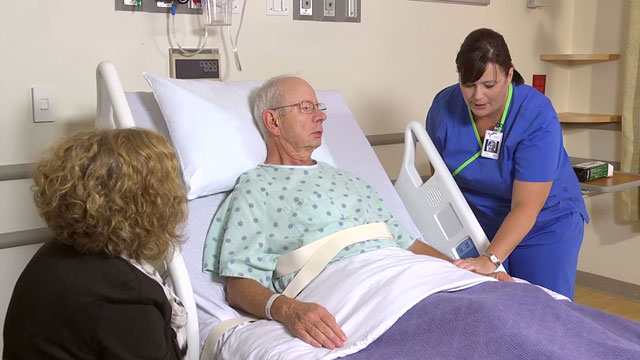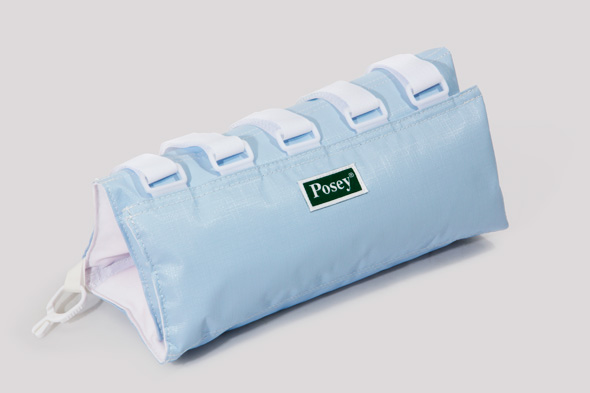Restraints and Alternatives
Select a Skill:
Take the Review Test:

Safety
- Place the patient in the lateral position, or elevate the head of the bed. The patient with extremity restraints is at risk for aspiration if placed in the supine position.
- Use a quick release tie to secure the restraint.
- Ensure that the restraint does not interfere with equipment, such as an IV, and is not placed over an access device, such as an arteriovenous shunt.
- Do not attach the straps of a restraint to the side rails of the bed.
- Do not tie the straps of a restraint into a knot.
- Check the skin under the restraint for abrasions.
- Change wet or soiled restraints to prevent skin breakdown.
- Remove a restraint immediately if the patient has an alteration in neurovascular status of an extremity, such as cyanosis, pallor, or coldness of the skin, or if the patient complains of tingling, pain, or numbness in the restrained extremity.
Equipment
(Roll cursor over items to see labels)

Wrist Restraint
Mitten Restraint
Belt Restraint

Elbow Restraint
Delegation
The skills of assessing a patient’s behavior and level of orientation, determining the need for restraints, selecting the appropriate restraint type, and performing the ongoing assessments required while a restraint is in place cannot be delegated to NAP.
The application and routine checking of a restraint, however, can be delegated to NAP. The Joint Commission (TJC, 2009a) requires that anyone who monitors a restrained patient, including NAP, be trained in first aid. Be sure to inform NAP of the following:
- Correct placement of the restraint and how to routinely check the patient’s circulation, skin condition, and breathing
- When and how to change a patient’s position or provide range-of-motion exercises, toileting, and skin care
- To notify you immediately if there is a change in the level of the patient’s agitation, skin integrity, circulation of the extremities, or breathing
Preparation
- Assess the patient’s behavior for confusion; disorientation; agitation; restlessness; combativeness; repeated removal of tubing or other therapeutic devices; and inability to follow directions.
- Follow your agency’s policies regarding restraints. Check the health care provider’s order for the purpose, type, location, and time or duration of the restraint. Determine whether a signed consent document for restraint use is needed.
- Review the manufacturer’s instructions for restraint application, and determine the most appropriate size restraint.
- Inspect the area where the restraint is to be placed. Note if there is any nearby tubing or devices. Assess the condition of the patient’s skin, sensation, adequacy of circulation, and range of joint motion.
Follow-up
- After applying a restraint, evaluate the patient’s condition for signs of injury every 15 minutes.
- Remove the restraints at least every 2 hours, and assess the placement of the restraint, patient's circulation, skin condition, position and provide range of motion exercise, toileting and skin care.
- Evaluate the patient for any complications of immobility.
- Routinely observe the patient’s IV catheters, indwelling urinary catheters, and drainage tubes.
- Continually evaluate the patient’s need for restraints according to agency policy.
- When a restraint is used for a patient with violent or self-destructive behavior, a licensed health care provider must evaluate the patient in person within 1 hour of initiating the restraint.
Documentation
- Record the patient’s behavior before and after the restraints were applied, the patient’s level of orientation, and the patient’s or family member’s statement of understanding the purpose of the restraint and his or her consent, if consent is required.
- Record any alternatives to restraints that were attempted and the patient’s response to them.
- Record the reason for the restraint, the type and location, the time at which the restraints were applied, the time at which the restraints ended, and the routine observations made every 15 minutes (or per agency policy), including skin color, pulse, sensation, vital signs, and behavior.
Review Questions
1. To which patient might the nurse apply a physical restraint?
 An 83-year-old patient with dementia and a history of wandering whose fall risk assessment indicates a high risk of falling
An 83-year-old patient with dementia and a history of wandering whose fall risk assessment indicates a high risk of falling A 42-year-old critical care patient with a traumatic brain injury who has repeatedly tried to pull out her shunt
A 42-year-old critical care patient with a traumatic brain injury who has repeatedly tried to pull out her shunt A 74-year-old patient confined to bed that is at risk of pressure ulcers
A 74-year-old patient confined to bed that is at risk of pressure ulcers  A 60-year-old patient with dementia who seemed increasingly confused shortly after having had restraints applied for 1 hour that morning
A 60-year-old patient with dementia who seemed increasingly confused shortly after having had restraints applied for 1 hour that morning
2. Why does the nurse instruct nursing assistive personnel (NAP) to remove the wrist restraint of a confused patient every 2 hours?
 To try a less restrictive type of restraint if a more confining restraint has proved effective
To try a less restrictive type of restraint if a more confining restraint has proved effective  To double-check the size by inserting two fingers between the wrist and the restraint
To double-check the size by inserting two fingers between the wrist and the restraint To check the skin integrity and range of motion of the wrist
To check the skin integrity and range of motion of the wrist  To comply with Joint Commission standards
To comply with Joint Commission standards
3. What would the nurse instruct nursing assistive personnel (NAP) to report when caring for a patient in a wrist restraint?
 “Tell me if the patient’s pulse changes.”
“Tell me if the patient’s pulse changes.”  “Tell me if the skin under the restraint becomes abraded or raw.”
“Tell me if the skin under the restraint becomes abraded or raw.”  “Let me know if you think she’s ready for them to come off.”
“Let me know if you think she’s ready for them to come off.”  “Let me know if the patient needs anything for pain.”
“Let me know if the patient needs anything for pain.”
4. The nurse is discussing the risk of falling with the wife of a patient with cognitive impairment. What is the nurse’s best response when the patient's wife says, “I don’t like him being tied down in the bed?”
 "I’m sure you don’t want him to fall again."
"I’m sure you don’t want him to fall again." "Can you suggest an alternative?"
"Can you suggest an alternative?" "What did you do to prevent him from falling when he was at home?"
"What did you do to prevent him from falling when he was at home?" "We will try all other alternatives before using physical restraints."
"We will try all other alternatives before using physical restraints."
5. When a nursing assistive personnel (NAP) enters the room of a patient in a belt restraint, he finds the patient’s gown bunched around the patient’s chest and the patient asking for help. What would the NAP do?
 Check the patient’s blood pressure and pulse before smoothing the gown
Check the patient’s blood pressure and pulse before smoothing the gown  Untie the restraint and smooth the patient’s gown
Untie the restraint and smooth the patient’s gown  Put on the call light for help
Put on the call light for help  Ask the patient what specific help she would like
Ask the patient what specific help she would like
You have completed the Review Questions for this skill. To take the Review again select the Start Over button. To proceed to another skill select from the dropdown menu. Select the Home or Back button to proceed to the next section.

